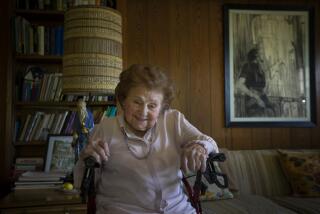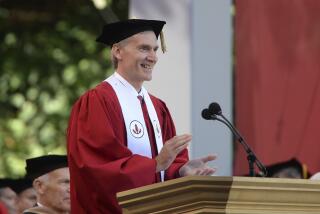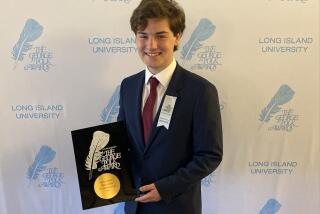Paul Berg, scientific firebrand who pioneered genetic engineering, dies
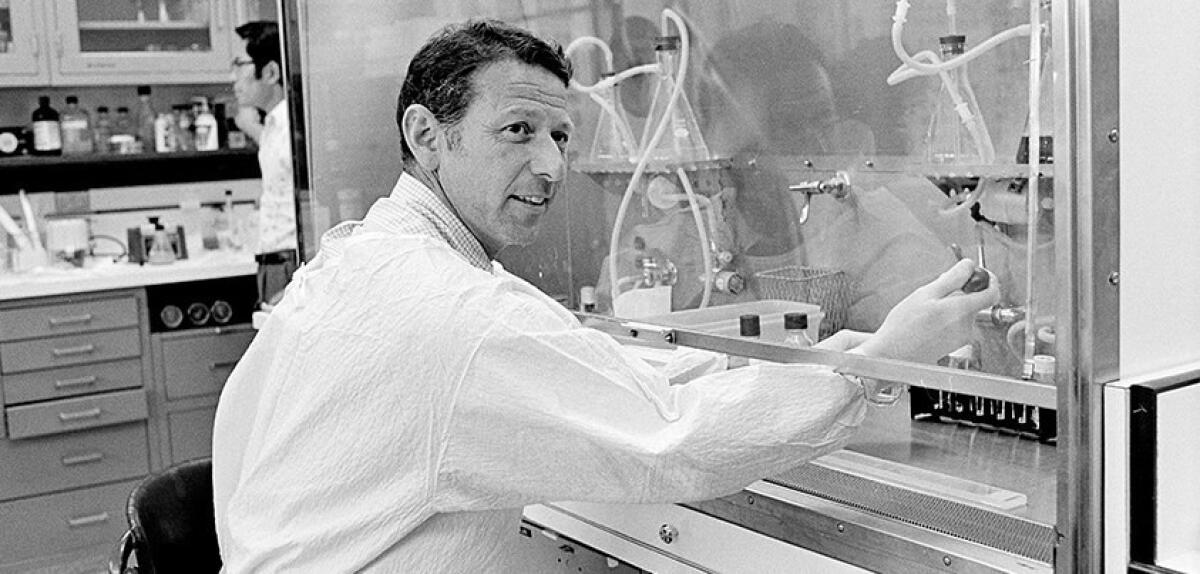
)
- Share via
Paul Berg, the Nobel Prize-winning biochemist whose ground-breaking experiments in gene-splicing reshaped cancer research and helped spawn the multibillion-dollar biotechnology industry, has died at his home on the Stanford University campus.
Berg’s Feb. 15 death was announced by the Stanford School of Medicine, which did not cite a cause. He was 96.
The son of impoverished Russian immigrants, Berg was among the first to show that it was possible to manipulate the machinery of life to fight disease and create a range of genetically modified crops and organisms that few imagined possible.
“His discoveries changed the way drugs are produced and transformed the whole industry of biotechnology,” said Philip Pizzo, the former dean of the Stanford School of Medicine, where Berg spent most of his career.
“Paul’s work not only had an impact because of what he did in the lab, but also how much he contributed” to public policy, Pizzo added.
An example was his realization that the genetic engineering technique he pioneered could be used to spread super-pathogens around the world. In response, Berg halted his own research and helped draft a moratorium on gene editing in the 1970s.
Years later, he played a leading role in California’s Proposition 71 campaign, which raised $3 billion for stem cell research, this time facing down critics from conservative religious groups who felt scientists were trying to play God.
“Scientists who synthesize genes by chemical techniques in their laboratories do not think of human DNA molecules as holy,” was Berg’s plainspoken response.
Did the California stem cell program promise miracle cures?
Despite his role as a scientific firebrand, Berg remained an essentially modest man who made it a policy to never bring up his status as a Nobel winner. He violated the oath only one time, he said, while trying to convince a merchant that his check would not bounce.
Berg was born June 30, 1926, in Brooklyn, the eldest of three sons of Harry and Sarah Brodsky Berg. After emigrating from Russia, Berg’s father started a business manufacturing fur hats and coats, but was never successful. Family circumstances were “modest to poor,” Berg recalled.
His mother encouraged his interest in science, but his father was dubious. “When are you going to make a living? Science is like a hobby,” he scoffed, when his son decided to continue his education after high school.
At Abraham Lincoln High School in Brooklyn, Berg was one of three students, including Arthur Kornberg and Jerome Karle, who would go on to win Nobel Prizes. He earned his doctorate at Western Reserve University (now Case Western Reserve) in Cleveland, then conducted postdoctoral work in cancer research in Denmark.
In 1956, he joined his schoolmate Kornberg’s lab at the Washington University School of Medicine in St. Louis, as an assistant professor of microbiology. Three years later, Stanford came calling. The university medical school planned to open a new department of biochemistry, with the idea of linking scientists to clinicians, a philosophy Berg called “bench to bedside.”
“If I can bring my entire department, I will come,” Kornberg said, according to Berg. “Be our guest. Bring your crew,” was Stanford’s response.
Seven young, ambitious investigators decamped from Missouri to California, arousing some criticism in academia at the time. But, according to Berg, it proved to be a fortuitous, and historic, development. An already assembled team got a clean slate at their new home.
“We could do lots of things that you couldn’t do in other places because it would have been against the prevailing culture,” Berg said. “But at Stanford we made our own culture.”
In the late 1960s, he began experimenting with viruses to find out how they alter genes, and how normal cells turn cancerous. He cut the DNA of a monkey virus into pieces and inserted them into a second virus that infects a common human intestinal bacterium called E. coli, creating a shared strand of DNA. The process became popularly known as recombinant DNA.
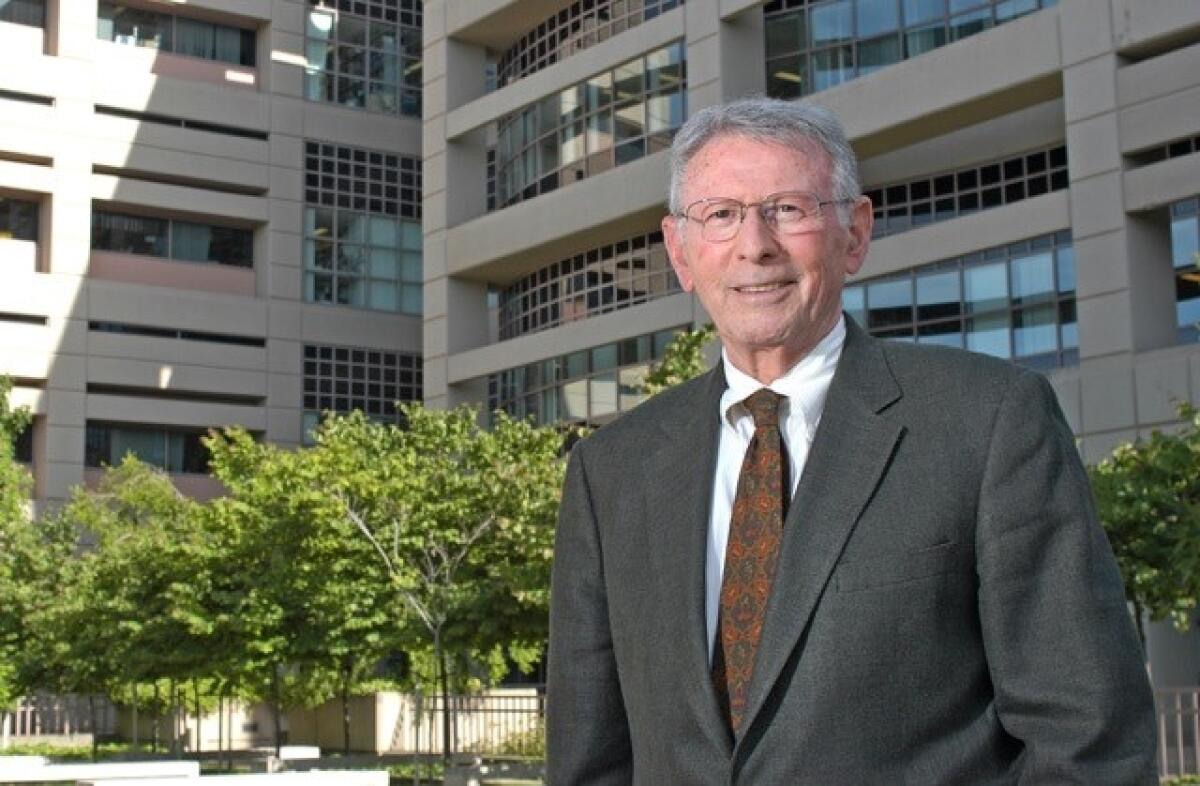
Berg planned to smuggle the new DNA chain into the E. coli bacterium, but suddenly realized the danger of inserting a tumor gene into a bacterium that exists everywhere in the environment, both in animals and humans. If it ever got out of the laboratory, the results could be catastrophic.
He stopped his own research and called for an international conference to discuss the “potential biohazards of recombinant DNA molecules.” The now-famous conference at Asilomar in Pacific Grove, Calif., in 1975 brought together 100 scientists from 16 countries, resulting in a temporary moratorium on gene-editing until the process could be proved safe.
The burgeoning biotechnology industry was less cautious. In 1976, Genentech was founded to take advantage of the new discoveries. Its initial public offering in 1980 set a Wall Street record for the fastest rise in price per share — $35 to $89 in 20 minutes. Today, the industry is an international behemoth, employing thousands in research on genetic engineering.
The same year Genentech went public, Berg received the Nobel Prize in chemistry, sharing it with Walter Gilbert and Frederick Sanger, honored for their research on nucleic acids. While admitting the award “opened doors,” Berg was self-conscious about it. Throughout the rest of his life, he found it hard to tell people that he was a Nobelist. Every year, the Swedish academy organizes a luxury retreat in Germany for past award winners; Berg never attended.
According to Pizzo, this was entirely characteristic of a scientist he called “humble in so many ways.”
One of those ways was his refusal to use his newfound biotechnology wealth to buy the kind of opulent home that appealed to other Silicon Valley innovators. He continued to live with his wife, Mildred, in the simple house on campus he bought for $25,000. His one indulgence was modern art, particularly pieces by Robert Motherwell and Sam Francis.
When a new learning center was to be built on campus, he donated $4 million to the project, saying it was only appropriate that he give back for all the honors Stanford had brought him. He also raised $50 million for the Beckman Center for Molecular and Genetic Medicine, which opened at Stanford in 1989. He found that raising money came as naturally to him as laboratory work.
“When I’m excited about something I don’t have any hesitation expressing that excitement,” he explained. He became the center’s first director.
Berg next took a leading role in the public furor over the use of stem cells to cure disease. Scientists had discovered that embryonic stem cells, basically a cluster of cells in a few-days-old embryo called a blastocyst, could turn into every kind of cell and organ in the body. In just one example, it was thought that if stem cells could be made to produce healthy pancreatic cells, juvenile diabetes might be cured.
President George W. Bush restricted the use of federal funds in stem cell research after several religious groups protested that a days-old embryo was a human life.
Berg was exasperated. “It’s what I call un-American, to even think in those terms!” he said of Bush’s decision. He pointed out that the blastocysts, which came from fertility clinics, were going to be destroyed anyway.
He subsequently became a leading advocate of California’s Proposition 71 in 2004, which replaced federal research dollars with state taxpayer money. Stem cell cures proved elusive, however. In a 2017 oral history interview at Stanford, Berg admitted that proposition backers may have oversold the life-saving benefits of stem cells.
“Can you repair a heart after a heart attack with stem cells?” he asked. “That clearly didn’t work. But there are a lot of things still out there.”
While his work spanned many disciplines, it was the process of discovery that gave Berg his greatest joy. In the 2017 interview, he said he often told others, in language familiar to his students, that it was better than a drug high.
“You made something or you discovered something that nobody knew before or nobody was able to do before. That’s pretty heady.”
After his official retirement in 2000, Berg remained active. Even in his 90s, he continued to go to his campus office every day, and offered advice on changes in the medical school curriculum.
Berg was the Vivian K. and Robert W. Cahill Professor of Cancer Research, Emeritus. Among other honors, he was the California Scientist of the Year in 1963, a member of the National Assn. of Science, and a past president of the American Society of Biological Chemists. He won the Henry J. Kaiser teaching award at Stanford twice, was a Foreign Member of the French Academy of Sciences and the Royal Society, won the National Medal of Science, and was a Fellow of the American Assn. for the Advancement of Science.
Berg is survived by a son, Jack, and his brother John. His wife, Mildred Levy, died in 2021.
Johnson is a former Times staff writer.
More to Read
Start your day right
Sign up for Essential California for the L.A. Times biggest news, features and recommendations in your inbox six days a week.
You may occasionally receive promotional content from the Los Angeles Times.
